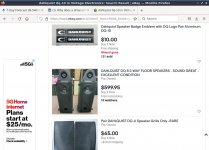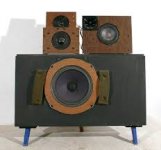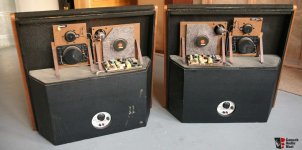This is just a way of saying there is extreme pressure loss at lower freq.s due to dipole cancellation.
Hey Scott, I got part way through answering you yesterday. I was preparing a reference and the search function on the forum dropped out.
Take a closed box. The 0th mode is a pressure mode in the box at low frequencies, where the cabinet breathes with the cone. The wall's natural reaction to being pushed away from its resting position is to come back at its own natural resonance frequency. Such a condition could be the cause of such things as one note bass, or be blamed for such things as a room mode.
Is wall = cabinet panel? or is wall = room wall?
If it's the latter, most walls in the US have at least vertical bracing every 16"s on-center. Some walls also have horizontal bracing about 3rd of the way up from the floor (and of course have horizontal bracing top and bottom). They can vibrate of course, but I doubt that there is enough *loudness to create an audible very low freq. droning effect, and my guess is that the panel resonance is not only attenuated (especially with common fiberglass batting pushing-up against the sheet rock wall) but is also higher in freq. (due to the bracing/sectioning of the panel) than the lowest room mode (unless the room is quite small).
*I have heard this condition before with a cheap house in a hurricane - high pressure extremely low freq.s modulated my home (the entire home, vibrating the framing) as the "eye" of the hurricane started to pass over the home. (..Hurricane Alicia in the early '80's in Houston with wind-speed over 155 mph at the home.) I went outside and could almost "stand" at a 45 degree angle. I'm sure that near-tornado touch-downs are far worse than this, even if a mile away.
Last edited:
OK. 🙂Hey Scott, I got part way through answering you yesterday. I was preparing a reference and the search function on the forum dropped out.
Wouldn't they need to have a pressure component to spread across the baffle, or to be ready to go around it?Realistically with velocity sources and their measured results in-room you could say they are only velocity sources to a few inches/centimeters at lower freq.s. just past the point of their null from the baffle's edge.
The diffractive element of the baffle's edge will certainly create pressure, it's more like once the soundwave actually null's that the typical "acoustic" definition for velocity becomes more relevant. (..or again, at least that's what I vaguely remember from about 3 decades ago.)
Really though, saying anything is a "velocity" or "pressure" source is an exaggeration - once you get really close to the emitting surface things get really strange with Velocity and Pressure and a typical cone diaphragm (so strange than when measuring the measurement is basically "averaged"). Most of the time as distance increases sound is described as pressure. Though again, I could be miss-remembering this.
I should probably try searching for more info. on this.. 😊
Really though, saying anything is a "velocity" or "pressure" source is an exaggeration - once you get really close to the emitting surface things get really strange with Velocity and Pressure and a typical cone diaphragm (so strange than when measuring the measurement is basically "averaged"). Most of the time as distance increases sound is described as pressure. Though again, I could be miss-remembering this.

I should probably try searching for more info. on this.. 😊
Now we are on page 6, and I feel like I should take a better "stab" at answering the OP. Why do they sound different? Whoops, I went back and re-read the opening line {{{Having listened to a bass/mid drive unit playing in free air (baffleless) and then listening to the same unit after being mounted in a sealed enclosure, I’m struck by the difference in sound. Obviously, I expected to hear more bass, but I didn’t expect the midrange to become more confused/distorted. I’ve tried with and without sound insulation, but the improvement with stuffing was relatively minor.}}}
Since the majority of drive units are designed to operate in an enclosure, the OP's findings do not make any sense, nor do they agree with my findings at all.
I don't know---maybe this was just a way to add fuel to the fire regarding OB speakers verses enclosures. There already have been 100's of thousands of pages written pro-and-con for either. Therefor there's no reason for me to continue an explanation.
To each there own. Simply enjoy what you find sonically pleasing to your own ear.
Since the majority of drive units are designed to operate in an enclosure, the OP's findings do not make any sense, nor do they agree with my findings at all.
I don't know---maybe this was just a way to add fuel to the fire regarding OB speakers verses enclosures. There already have been 100's of thousands of pages written pro-and-con for either. Therefor there's no reason for me to continue an explanation.
To each there own. Simply enjoy what you find sonically pleasing to your own ear.
Ramista - In short, diffraction effects caused by baffles and your ears are more sensitive in the midrange. For bass drivers, baffling is necessary of course, I only build speakers that use either sphere enclosures or no baffles for the midrange and hi frequency drivers (such as sealed domes - such as 2" or 3" for mids). Place your hands on either side of your mouth and talk or sing, your voice will sound different. Imagine that happening on either side of a clarinet, or other instrument in the middle range? For smaller woofers (6" say), you can consider shallower cones that have less diffraction inherent within the cone itself (deeper cones will have more as the mid frequencies tend to be generated in the center of the cone). Diffraction effects are not distortion per se, they change tonality. As for rear waves off of woofers, enclosures with parallel sides and insufficient reinforcing and damping will affect the bass.
Indianajo - the Dahlquist 10 speakers introduced in the mid-70s had minimal baffles on the mid and hi freq. drivers, so the "open baffle" or min. baffle concept existed in those days. Boxes are just easier to make in mass production. And easier to package and ship. And they don't sound bad (the AR 3a was a very good speaker) just open baffle or spheres have advantages to reduce diffraction - Gallo, DBA and Cabasse have all done extensive research into this. I build spheres BUT they are hard to do, But also worth the reward (ala Dr. Olsen's research back in the 50s). The original Walsh driver in Ohms, while firing into a cabinet for the bass, generated upper bass, mids and highs from the outside of the tall cone. Omnidirectional and open baffle. These are still considered innovative drivers, developed in 1969 and available for sale by 1972 I think.
Virtually ALL dynamic drivers are intended to be operated in an enclosure, even the ones that are so-called Open Baffle designs, and it's almost completely because of pressure loss. (Quality Factor is also another reason, but most people like more damping (at least magnetic) not less.)Since the majority of drive units are designed to operate in an enclosure..
Being "designed to operate in an enclosure" does NOT mean: "will sound better than not in an enclosure" at least not if the driver is eq.ed/high-passed properly and is limited to a reasonable power input under that condition.
Now we are on page 6,
To each there own. Simply enjoy what you find sonically pleasing to your own ear.
I think that last sentence was the best part 😉.
Finally some light. ebay has a pair of dahlquist 8 speakers for only $200 more than I paid for of my SP2(2004). $600 https://www.ebay.com/itm/234498431827?hash=item3699321b53:g:S1gAAOSwp~5iTnw5 Dahlquist 8 is pretty obvious bass reflex box for a 10" woofer 50 cm? high. On top of that a triangular flange for a 3"? 4"? tweeter. Tweeters don't gain anything from the box except shipping/cat/dog/child protection. OB would be fine 3000 hz up. Room effect dominates radiated sound from naked tweeter with small open baffle. .Indianajo - the Dahlquist 10 speakers introduced in the mid-70s had minimal baffles on the mid and hi freq. drivers, so the "open baffle" or min. baffle concept existed in those days.
I'm building some SP2-XT copies (15"+1.4"CD) to replace my stolen ones, that will mount the 1.4" CD horn naked on a pole. Outside the box. Saves 10 lb from the box, making it easier to put the woofer bass reflex box on a pole with 15" driver head high. I'm age 71 and I can't lift 92 lb SP2-XT 66" high anymore. OTOH, I don't imagine a titanium compression diaphragm enclosed in an aluminum can voicing through a 3 mm thick plastic horn would project much sound 1200 hz up through a 15" woofer mounted 24" below it. Even if the box wasn't stuffed (which it is).
Attachments
I read somewhere that its success was fine tuning the crossovers for tweeter and supertweeter to match square wave as closely as possible.
Perhaps someone should manufacture a gadget that generates a square wave ( electronic ) signal, and picks up sound on a mic, and compares the two. I wonder if you played a square wave in a recording studio, it would still be a square wave on the end of someone's hi fi.
yeah, not the best A/B comparison images for sure. I did them at different times in different boxes with the mic close to the driver. The greater point was the decay has a 1ms shift just 5db down vs no stuffing. This can be seen no matter the settings.These two graphs are miles apart... one is smoothed at 1/6 and the other at 1/24, the scale is different and the timing settings (window, rise time) are different too.
Not quite telling a useful story this way. No way of knowing how clean those windows are at 23 ms or even worse 30 ms, what are we looking at? If it's a measurement
from within a room, there's quite a bit of 'room' in the pictures here already. I'd bet we're not looking at the results of the driver + box here by itself, isolated from other factors.
Someone new to this hobby reading this thread would not believe one can put a driver in a box and obtain a good result... 😳
So it shows your stuffing example was rubbish, but it's not telling us stuffing in general does not work 😉
A sealed box and stuffed full range line array (2015):

If stuffing would cause problems it sure would surface with 25 drivers all doing the same... the top end troubles should be
obvious with it being an unfiltered 25 driver array EQ-ed flat.
During stuffing I run impedance tests of driver in box. That tells me if I have enough stuffing to reduce box resonances
(compared to the same driver in free air) and it even shows me when I'm over stuffing...
A sealed box and stuffed full range line array (2015):
If stuffing would cause problems it sure would surface with 25 drivers all doing the same... the top end troubles should be
obvious with it being an unfiltered 25 driver array EQ-ed flat.
During stuffing I run impedance tests of driver in box. That tells me if I have enough stuffing to reduce box resonances
(compared to the same driver in free air) and it even shows me when I'm over stuffing...
I did do this before with an sb 5" coax. I'll have to find that file and look at the decay graphs. I do have the waterfalls handy with diff. stuffings:So it shows your stuffing example was rubbish, but it's not telling us stuffing in general does not work 😉
A sealed box and stuffed full range line array (2015):
View attachment 1056349
If stuffing would cause problems it sure would surface with 25 drivers all doing the same... the top end troubles should be
obvious with it being an unfiltered 25 driver array EQ-ed flat.
During stuffing I run impedance tests of driver in box. That tells me if I have enough stuffing to reduce box resonances
(compared to the same driver in free air) and it even shows me when I'm over stuffing...
This was the first time I noticed stuffing slowing down the decay.





These all had the same driver and same box.
- Home
- Loudspeakers
- Multi-Way
- Why does a drive unit sound so different when placed in an enclosure?



